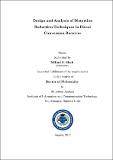Design and analysis of distortion reduction techniques in direct conversion receiver
Abstract
Direct-conversion is alternative wireless receiver architecture to the well-established super heterodyne architecture. Direct-conversion receiver (DCR) can offer highly integrated, low-power and low-cost hardware Solutions for wireless/Cognitive Radio devices. However, direct conversion receivers are very sensitive to various RF impairments, which degrade its performance. This report present analysis and design of distortion reduction technique in direct conversion receiver (DCR). Such method enhances the overall performance of DCR by enhancing its immunity to various types of distortion. Here modification in classical homodyne architecture is presented to make DCR more insensitive to distortion, with a stress put on minimum changes in the RF analog section with maximum ability of distortion removal. The proposed method gives liberty to the designer whether to incorporate in analog section or in the back-end Digital Signal Processing (DSP) section. Detailed investigation is carried out about the distortion reduction ability of proposed method. Theoretically, it is shown that roposedstructure is able to reduce/remove (i) I/Q mismatch (ii) Even order distortions. Practically measured results also support theoretical claim. In addition, the results also show the ability of this method to reduce DC-offset distortion also. A simple but efficient method for calculation of optimized coefficients, which is able to remove distortion, is also presented. Theoretical results are first verified with analysis and later validated by experimental hardware setup. The results show the better performance of modified DCR architecture than conventional DCR architecture. With the proposed structure, a self-calibration procedure, without the need of extra hardware, can be implemented in direct conversion receiver to make it robust against distortions.
Collections
- PhD Theses [87]

